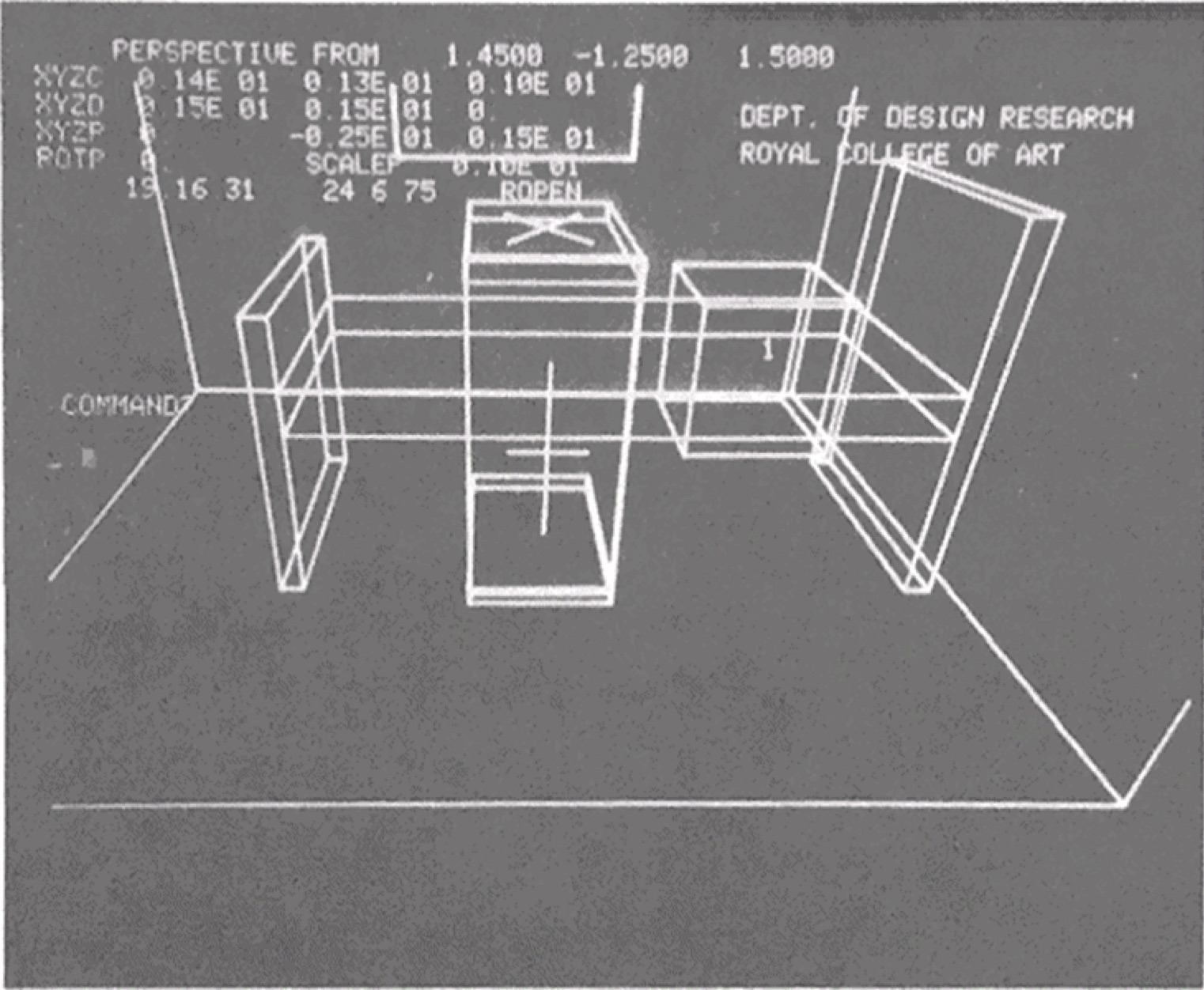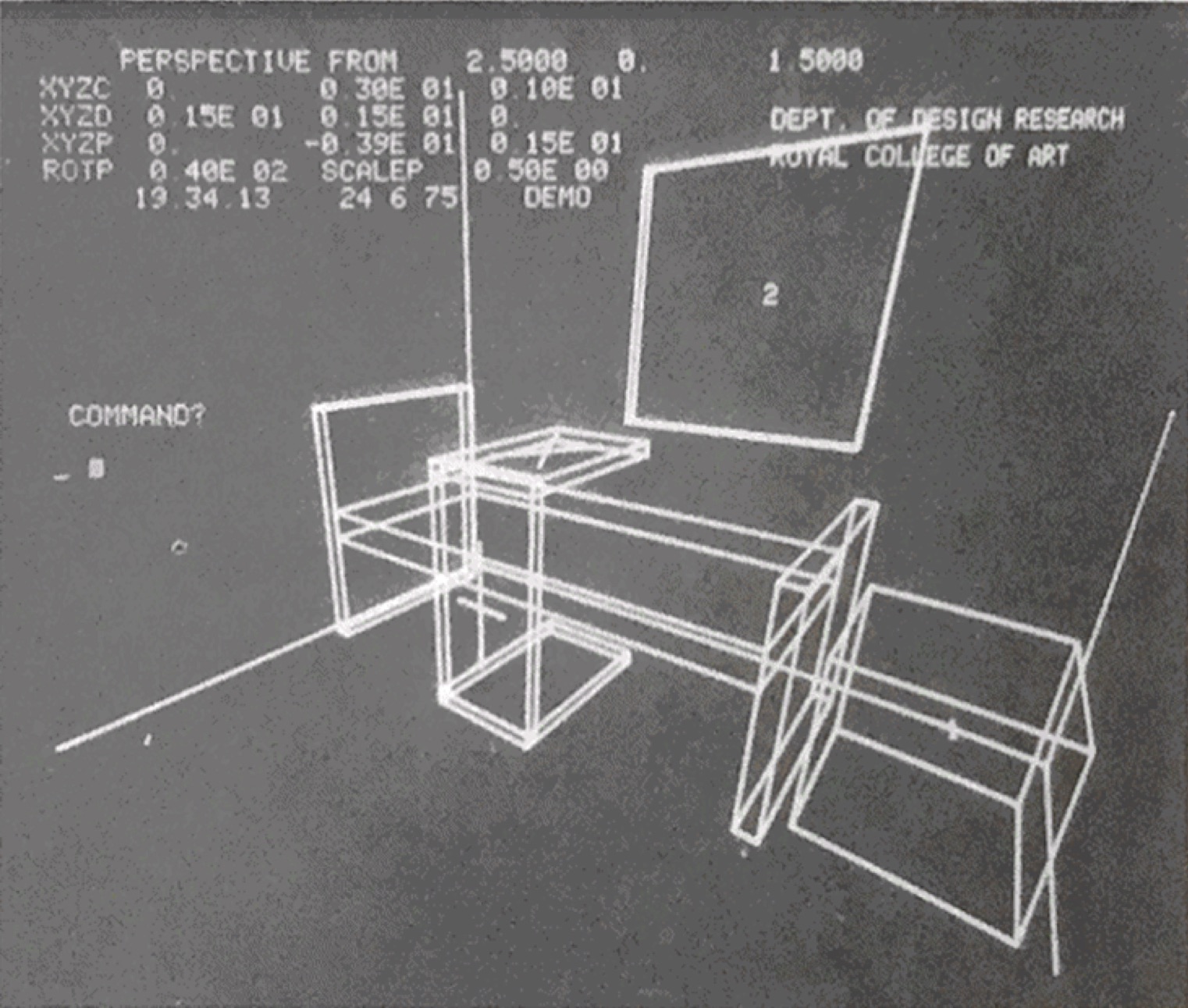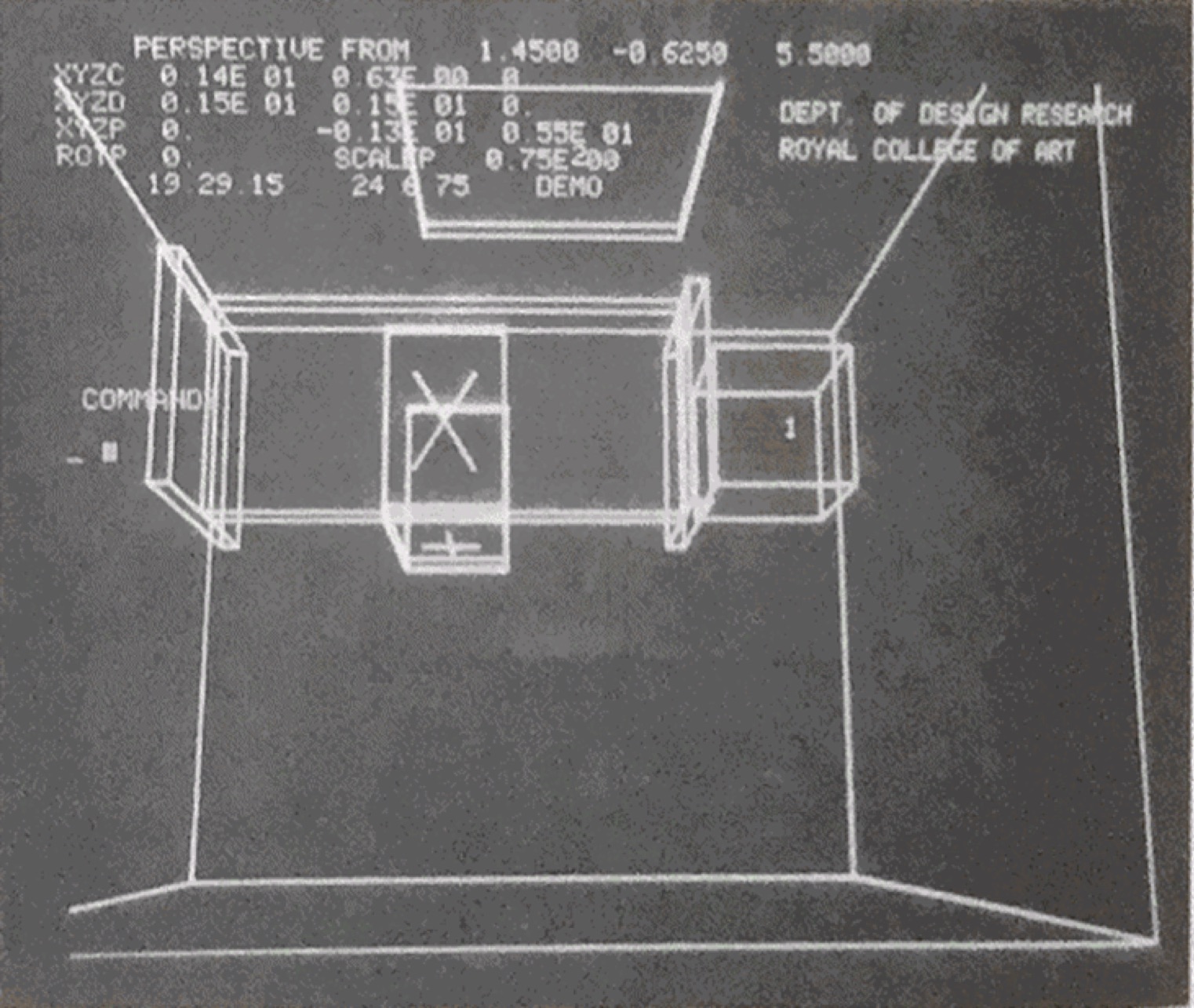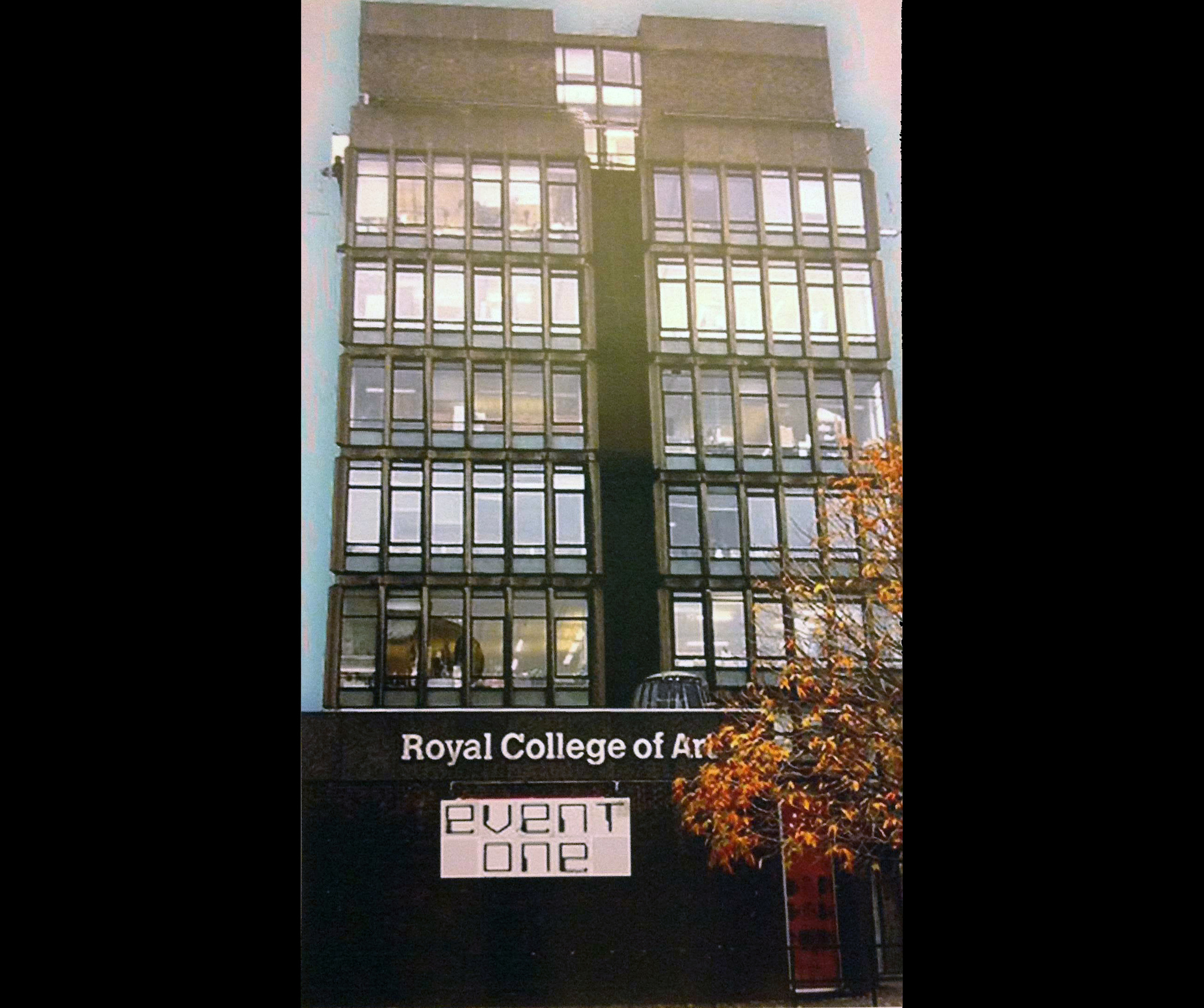The screen images are taken from the RCA yearbook of 1976, where they are described as 'computer generated wireline drawings of the area acute to a hospital bed, developed to determine the potential value of three-dimensional sketches to designers and their clients.'
The photo of the RCA building shows the sign for Event One in 1969.
The Department of Design Research pioneered the applications of computing at the RCA and, as we explain in the main article, responded to the widespread enthusiasm for computers as provocations to thought, rather than mere tools, of the 1950s and 60s.
Computing was applied - with mixed success - to the Hospital Bed project, using punched cards on the Atlas computer at Manchester University.
In 1970 the RCA Calendar announced that the Research Unit's 'membership is drawn from a variety of disciplines, ranging from industrial design to computer technology and psychology.'
In 1973 they announced 'permanent lines to the computer system at the Cambridge Computer-Aided Design Centre. The terminal centre houses an interactive graphic display linked to an Elliott 905 satellite computer, as well as a number of teletypes and graphic displays linked directly to the Atlas computer at Cambridge.'
A Landmark Event
Event One was the first exhibition of the Computer Arts Society (CAS). Conceived in 1968 and officially founded in 1969, CAS was the first practitioner-led organisation in Britain created 'to promote the creative use of computers in the arts, and to encourage the interchange of information in this area' (Computer Arts Society c.1969). Staged in March 1969 at the Royal College of Art, Event One included participants from architecture, fine art, computer programming and filmmaking among others, and offered a range of visitor experiences from sculpture and graphics to live performance and workshops. Catherine Mason (2009) suggests that 'Event One heralded the collaborative, cross-disciplinary nature of working which came to signify the early period of media arts in Britain, where interactivity and process were as equally valued as object.'
A Call to Action
In Design magazine in 1968, Patrick Purcell described the 'Cybernetic Opportunity' for computing in design. He pointed out the growth in adventurousness and flexibility in designing that computing ought to make possible, but also demanded that designers seize and control these opportunities.
Besides getting designers to reorganise and exploit the opportunities offered by computer-aided design, there is also a need for the trained designer who can collaborate with the computer scientist in developing new techniques and in validating prototype computer-aided design programs. To do this effectively, the designer must have well developed insights into computer science and technology. So the problem is essentially an educational one, and the solution lies in the new postgraduate courses being established for graduate designers. ...
... If designers do not make the effort, they should not expect the computer industry to do it for them. Nor should they complain if they lose the ability to communicate with the other members of the design and production team. (Patrick Purcell 1968).
George Mallen wrote in an obituary for Purcell in 2007:
He had early recognised the potential importance of computing and computer graphics to the art and design world and used his position as Senior Research Fellow in the Design Research Unit at the Royal College of Art with great flair to bridge the two cultures gap. He was one of that rare breed, a conduit for ideas and a selfless enabler of action. Sensitive to the needs of creative individuals and the institutional challenges of channeling that creativity he built a substantial portfolio of Science Research Council funded projects, no mean feat, at the RCA. I had the good fortune to work with him on these projects throughout the 1970s. (Mallen 2007).
On a lighter note, he also recalled:
Patrick's invaluable contribution to CAS was as enabler of the Society's inaugural exhibition, Event One, at the RCA in 1969. He was the interface for both the RCA and Imperial College. Heroically Patrick persuaded Prof Bill Elliot at IC [Imperial College] to loan, and the RCA to accept for a weekend, a PDP7 computer which had to be loaded onto a truck at Imperial College, driven 500 yards to the RCA, unloaded and installed in the Event One exhibition hall. I cherish the memory of Patrick, as always elegant of waistcoat, patrician of demeanour, marshalling the truck driver up the very narrow Jay Mews to the College back entrance. I suspect this was the first computer to penetrate the RCA.
not a Tool like any other
The mid twentieth century saw the proliferation of new ideas and interest in the inner workings of the brain and body, for example in neural networks and cybernetics, as well as advances in areas such as Operations (or Operational) Research (OR). Dramatic advances in thinking as well as technology emerged from World War II generating new discourses across a diverse range of disciplines, influencing pioneers of the use of computing technology in design such as Archer and his colleagues. They continued to pursue new theories and practice throughout their careers.
The adventurous, sometimes perhaps confused, spirit of the early days produced a variety of possible models for computing’s relationship to design (Gristwood and Boyd Davis 2014). The following summarises some of the key points of our 2014 paper, with updates and revisions.
Computing as a model for systematic designing
Operations, or Operational, Research (OR) emerged during World War II as a form of systematic decision-making using science-based mathematical and statistical approaches (Miller and Starr, 1960: 104), focusing on the relation between humans and systems or environments (Ackoff, 1961, p.6). Applied to design, OR emphasised sequential processes such as gathering data, and weighting it before proceeding with the design, in contrast to the perceived excess of intuition and tradition in standard design practice. It was his interest in systematic enquiry that led Archer to computing, as he saw its logic as a way of generating 'effective systematic methods for solving design problems' (Archer, 1963, p.1). He also saw ways of thinking about computing as 'valuable indicators of the sort of logic which might work even without a computer' (ibid).
The influence of cybernetics
While OR emerged from the management of man-machine processes, cybernetics originated as much in the feedback and control mechanisms of war machinery as in human contexts. Wiener’s 1948 idea (Wiener 1961) attracted interest from diverse disciplines. In design, the influence of cybernetics involved a particular emphasis on feedback and auto-reconfiguring, supporting a model where design does not follow research, but interacts with it. Figures such as Beer, Pask and Ashby in Britain were particularly influential on researchers such as Archer – who cited all three in the bibliography to his thesis (Archer, 1968) – and George Mallen, discussed below. In a series of works over several years, Glanville (eg. 2007) continued to pursue the relationship between cybernetics and design.
Reflexive computational models
If the use of OR or cybernetics harnessed computationally-inspired methods to improve design, the reflexive approach to computing asked the opposite question: what can we learn about designing by modelling it computationally? There are clear signs of such an approach in Archer’s work: he claimed only to undertake major design projects like the hospital bed in order to augment his understanding of design (C Frayling, pers. comm. to S. Boyd Davis. 10 June, 2013). Ashby’s Design for a Brain (1960) exemplifies similar reflexive thinking within cybernetics.
Qualitative computing
Archer (1972) discusses two complementary uses of computing in a short but important paper, ostensibly about architecture but with relevance to all design, concerned with what he terms the quantitative and qualitative.
The main point of the paper was to address this key area as one where computers were not being used – 'the patterns of goals and values of the people concerned' and 'the relations between the attributes to which people attach value, and the objectives which they are trying to pursue' (op. cit. p.4). It concludes with an eager appeal for computer systems to be designed and used to support the qualitative, humanistic, ethical practices that architects and designers pride themselves on: he saw 'no reason why computer models should not be built for the handling of qualitative considerations.' (p.3)
Contextual computing
Contextual computing aimed to use information technology to provide knowledge relevant to the designer at the point of action. John Lansdown, who worked at the Department of Design Research from 1983 to 1986 and had often encouraged its computing activities prior to that, assumed that 'we cannot design anything without proper information and knowledge' and suggested that design failures do not necessarily amount to bad designing, but bad working practices (1989:5). The computer was suggested as a facilitator to improve the 'designer's information environment'. With the computer acting as a source of relevant information, the designer would have all the necessary knowledge throughout the process of designing.
Lansdown was originally an architect who began investigating the potential of OR and mathematics in architecture in 1960, which subsequently led him to computing as it became more available. He was a founder with George Mallen of System Simulation Limited, in 1977, a “private research and development company which was originally set up to further the research and computing aspirations of the architectural practice” (Lansdown, 1989). He innovated throughout his career with a diverse range of interests including CAD, Artificial Intelligence, and computer choreography as well as writing regular columns for the Computer Bulletin, mostly under the title Not Only Computing - Also Art, from 1974-1992. Like Archer, he was influential through serving on important bodies, including the British Computer Society Council (1980-83), and from the early 1970s to the 1990s had influential roles in professional bodies where he was credited with creating a “world leading strategy for developing Computer Aided Architectural Design in UK Universities” (CompArt Database of Digital Art, n.d). He was as interested in art and performance as he was in architecture and design. He was a founder member of the Computer Arts Society (CAS) along with George Mallen and Allan Sutcliffe, and sought to promote a cross-disciplinary understanding of computers.
Educating the designer: simulation
A landmark of early computing for design was Ecogame, developed by a team under George Mallen, by request of the British Equipment Trade Association, for the Computer ’70 trade exhibition (Mallen, 2008:194 ). This aimed, not to relieve the designer of hand work, but to illuminate the mind. A computer-managed simulation with output in the form of slide-projected images on the interior of a physical dome, it enabled the user to explore what-if scenarios with a given set of ecological resources.
Mallen graduated in physics and was originally an aeronautical engineer at Farnborough; he worked part time in Archer's department from 1970, and with Lansdown co-founded System Simulation in 1977 (where he recently retired as director of research). Like many of his contemporaries Mallen disregarded discipline boundaries; while Ecogame was initially seen by many as an artwork (Edmonds and Franco 2010), and the idea conceived at a meeting of the Computer Art Society (Mallen, 2008:194), a version was commissioned for the First European Management Forum in Davos in 1971 (Lambert, 2011). As Lansdown (1988) remarked 'The ground-breaking Ecogame exhibit at Olympia in 1970 showed how computer art could change our way of thinking about environmental problems (and, incidentally, about computing too)'. Mallen commented in retrospect that 'it was very high risk but those of us involved were hopelessly optimistic and totally committed, which are key factors in an innovation' (Mallen, 2008:194).
Dialogical computing
The influential book Soft Computing: Art and Design (Reffin Smith, 1985) set computing in a broad intellectual context. The 'softness' of the title is reflected in the author’s emphasis on the qualitative and it is worth recalling that he too was situated in Archer’s department at the RCA as a research fellow, and college tutor from 1979-1984, principally to educate the college’s own students in computing.
Reffin Smith remarks that 'we ought sometimes to consider the use of computers to handle representations, and we ought to be aware of what's going on when we do that.' (p.102). It is notable that the word 'representations' does not limit the discussion to the visual or even the sensory; it may just as well refer to ideas perhaps expressed in language. An apparently trivial example of computer use offered by Reffin Smith is a 52-line program in the simple computer language BASIC (p.57-8). The program invites the user to name an entity, for example 'chair', and to assign six descriptive attributes to it. The user must then provide six alternatives to each attribute, 36 in all. The program responds with a new description of the original entity using six attributes chosen at random from the alternative sets the user just provided. In terms of design thinking, this is no more than the mechanisation of a creativity prompting scheme, less sophisticated computationally even than ELIZA (Weizenbaum, 1966) of twenty years earlier, but the point is to provoke reflection. Like many of his contemporaries, Reffin Smith was interested in the nature of designing, the nature of computing, and the potential relations between them.
Computers as tools
One of the most obvious applications of computational machinery has been to relieve humans of tedious, error-prone, repetitive tasks, an approach with origins in pre-computer devices such as the Jacquard loom and Tull’s seed drill.
Archer discusses such uses of computing in the paper on the qualitative discussed above (Archer 1972). He assesses claims that 'the computer could free the architect from burdensome preoccupation with (largely quantitative) chores and thus permit him to spend more of his time and energy on the handling of the (mainly qualitative) broader issues' (p.1). Archer expresses strong reservations, based on his examination of computing in engineering design, as to whether such freeing does in fact occur. Perhaps more sanguine than Archer, Lansdown thought that by using the computer to do easily what might be difficult to do by hand, 'the effect on the creative process can be profound' (1985, p.19).
There is no doubt that the computer has subsequently augmented or replaced many craft operations, usually on an assumption that (1) time will be saved and (2) the saved time will be spent on more rewarding aspects of designing. This notion of the computer as 'just a tool', one that is no more important intellectually than a trowel, an airbrush or a scalpel, but is rather a prosthetic extension of the hand, is arguably the dominant one of our time.
The categories of early design computing discussed above, however, are predominantly concerned with the designer’s mind. They emerged from an optimistic tradition in relation to computing where the machine augments mental capability, exemplified by Bush’s As We May Think (1945), Engelbart’s Augmenting Human Intellect (1962), Nelson’s Literary Machines (1980) and Berners-Lee’s Information Management: a proposal (1989). These key texts are not primarily about easing hand-work. If computers here are tools, they are tools for the mind.
Dissenting voices
In addition to his disenchantment with Design Methods, Christopher Alexander was emphatic in his condemnation of computing:
People who are messing around with computers have obviously become interested in some kind of toy. They have very definitely lost the motivation for making better buildings. (Alexander 1971)
Ackoff, Russell L. (1961) Progress in Operations Research. Volume 1. New York: John Wiley and Sons.
Alexander, Christopher (1971) State of the Art in Design Methodology: Interview with C. Alexander. DMG [Design Methods Group] Newsletter 5(3). 3-7.
Archer, L. Bruce (1963) 'Systematic methods – friend or foe?' Lecture to Architectural Association School of Architecture, Thursday 26 September 1963. Unpublished lecture notes, Bruce Archer Archive, Royal College of Art, London.
Archer, L. Bruce. (1968) The structure of design processes. Doctoral thesis, Royal College of Art, London, 1968. British Library Shelfmark: Document Supply DRT 484530. Available on Ethos.
Archer, L.Bruce (1972) Computers, design theory and the handling of the qualitative Proceedings of the International Conference on Computers in Architecture, University of York, 20-22 September 1972. Read this paper online.
Ashby, W Ross (1960) Design for a Brain: the origin of adaptive behaviour. London: Chapman and Hall.
Berners-Lee, Tim (1989) Information Management: A Proposal. Geneva: CERN. http://www.w3.org/History/1989/proposal.html (accessed 14 June 2016).
Boyd Davis, Stephen and Gristwood, Simone. (2016 - in press) Computing, Design, Art: Reflections on an Innovative Moment in History. In: Proceedings of the Third International Conference on the History and Philosophy of Computing (HaPoC 2015), Pisa, Italy, 8-11 Oct 2015. Springer.
Bush, Vannevar (1945) As We May Think. The Atlantic Monthly, July 1945. http://www.theatlantic.com/magazine/archive/1945/07/as-we-may-think/303881/ (accessed 14 June 2016).
Computer Arts Society. (c1969) Computer Arts Society: Aims, promotion leaflet drafted by Alan Mayne (undated c.1969). See the leaflet on the CACHe website.
Edmonds, Ernest and Franco, Francesca (2010, February 3) Art of Conversation. Symposium CAT 2010: Ideas before their time : Connecting the past and present in computer art. British Computer Society, London. 24-31.
Engelbart, Douglas C. (1962). Augmenting Human Intellect: A Conceptual Framework. (SRI Summary Report AFOSR-3223. SRI Project No. 3578). http://www.dougengelbart.org/pubs/augment-3906.html (accessed 14 June 2016).
Glanville, Ranulph (2007) Try again. Fail again. Fail better: the cybernetics in design and the design in cybernetics. Kybernetes 36 (9/10). 1173-1206.
Gristwood, Simone and Boyd Davis, Stephen. (2014) The Reappearing Computer: the past and future of computing in design research. In: Proceedings of DRS 2014: Design’s Big Debates. Conference of the Design Research Society, Umeå, 16-19 June 2014. http://drs2014.org/en/publications/ (accessed 14 June 2016). 618-632.
Lambert, Nick (2011) Chair’s Letter, Page: the Bulletin of the Computer Arts Society (Spring, 2011). 1.
Lansdown, R. John (1985) 'Computing in the Creative Professions' John Lansdown Archive, Middlesex University, JLA/1/1/17 Box 1
Lansdown, R. John (1988) Graphics, Design and Artificial Intelligence. In: Earnshaw (Ed.) Theoretical Foundations of Computer Graphics and CAD. Berlin, Springer.
Lansdown, R. John (1989) The designer's information environment: some tools for design knowledge manipulation, Civil Engineering Systems 6(1-2). 5-10.
Mallen, George (2007) Patrick Purcell (1929 - 2007) Leonardo Electronic Almanac 2007. http://leoalmanac.org/resources/luminaries/ppurcell.asp (accessed 14 June 2016).
Mallen, George (2008) Bridging Computing in the Arts and Software Development. In: P Brown, C Gere, N Lambert and C Mason (Eds.) White Heat, Cold Logic. British Computer Art 1960-1980. Cambridge, Massachusetts, MIT Press. 191-202.
Mason, Catherine (2009) The Fortieth Anniversary of Event One at the Royal College of Art" Proceedings of the 2009 international conference on Electronic Visualisation and the Arts, British Computer Society, 2009. http://www.bcs.org/upload/pdf/ewic_ev09_s5paper1.pdf (accessed 14 June 2016). 117-128.
Miller, David W. and Starr, Martin K. (1960). Executive Decisions And Operations Research. Englewood Cliffs, NJ: Prentice Hall.
Nelson, Ted (1980) Literary Machines. Sausalito CA: Mindful Press.
Purcell, Patrick (1968) Cybernetic Opportunity. Design 238 . 61-63.
Reffin Smith, Brian (1985) Soft Computing: Art and Design. Wokingham UK: Addison-Wesley.
Weizenbaum, Joseph (1966), ELIZA: A Computer Program For the Study of Natural Language Communication Between Man And Machine, Communications of the ACM 9(1).
Wiener, Norbert (1961) Cybernetics, or Control and Communication in the Animal and the Machine, 2nd edition, Cambridge, MA: M.I.T. Press.




